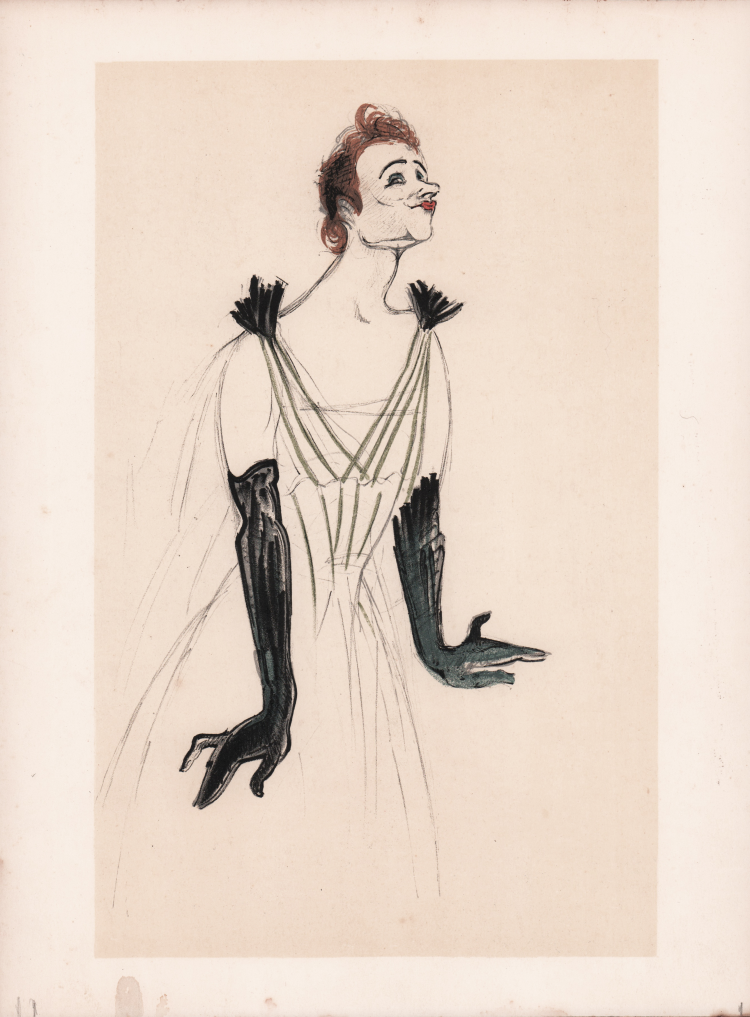



| Reference: | S42117 |
| Author | Henri de TOULOSE LAUTREC |
| Year: | 1900 ca. |
| Measures: | 170 x 270 mm |


| Reference: | S42117 |
| Author | Henri de TOULOSE LAUTREC |
| Year: | 1900 ca. |
| Measures: | 170 x 270 mm |
Litograph, after Henri de Toulouse-Lautrec.
Yvette Guilbert (Paris, January 20, 1865 - Aix-en-Provence, February 3, 1944) was a French singer, actress and writer. She was successful especially during the Belle Époque. Tailor, saleswoman and model in the Printemps stores, Yvette wanted to make her mark on the stage. She even performed at the Moulin Rouge, always wearing clothes that accentuated her shapes and taking unusual positions. She usually stood still on stage and while performing she gesticulated as if she were reciting a monologue. In 1894 and in 1898 she was muse of Henri de Toulouse-Lautrec, who dedicated two albums of portraits to her. With the album dedicated to Yvette Guilbert, Lautrec abandons any academic intention, to condense in a few effective strokes the expression of the body or face in its essence. Right from the cover, the artist chooses to pay homage to Yvette by representing her through her identifying element, which takes on the value of a logo, the long black gloves she usually wore during her shows. The increasingly concise rendering of the figure, stripped of any descriptive artifice, leads him towards a refined sign, rhythmic and spontaneous. In some prints Lautrec lingers on the longilinear appearance of the woman, enhancing the emotional charge of the moment lived on stage with the softness of color applied to spray, in others increases the intensity of communication by freezing the face in exaggerated expressions to the point of caricature, reminiscent of the masks of the kabuki theater discovered in Japanese prints, or dyeing the chiaroscuro decided to return the suggestion of the theater lit by the first electric lights.
Renowned Post-Impressionist painter, lithographer, and illustrator Henri de Toulouse-Lautrec captured the elegance and excitement of Parisian nightlife during the Belle Epoque. Though he was an aristocrat by birth, the artist was a fixture of the avant-garde bohemian scene centered in the Montmartre neighborhood—home of the famed Moulin Rouge, for which he made a series of promotional posters. Lautrec made the local artists, singers, showgirls, and prostitutes his subjects, capturing them in flat color, strong outlines, and unconventional angles and crops. Lautrec’s approach was inspired by Edo-period Japanese woodblock printing (known as ukiyo-e) and by fellow artists Edgar Degas and Édouard Manet—all three were keen observers of social culture.
Henri de TOULOSE LAUTREC (Albi 1864 - Maironè 1901)
|
Famous painter and lithographer. He became an important Post-Impressionist painter, art nouveau illustrator, and lithographer; and recorded in his works many details of the late-19th-century bohemian lifestyle in Paris. His career lasted just over a decade and coincided with two major developments in late nineteenth-century Paris: the birth of modern printmaking and the explosion of nightlife culture. Lautrec's posters promoted Montmartre entertainers as celebrities, and elevated the popular medium of the advertising lithograph to the realm of high art. His paintings of dancehall performers and prostitutes are personal and humanistic, revealing the sadness and humor hidden beneath rice powder and gaslights. Though he died tragically young (at age thirty-six) due to complications from alcoholism and syphilis, his influence was long-lasting. Lautrec's prints often display dazzling technical effects, as new innovations in lithography during the late nineteenth century permitted larger prints, more varied colors, and nuanced textures.
|
Henri de TOULOSE LAUTREC (Albi 1864 - Maironè 1901)
|
Famous painter and lithographer. He became an important Post-Impressionist painter, art nouveau illustrator, and lithographer; and recorded in his works many details of the late-19th-century bohemian lifestyle in Paris. His career lasted just over a decade and coincided with two major developments in late nineteenth-century Paris: the birth of modern printmaking and the explosion of nightlife culture. Lautrec's posters promoted Montmartre entertainers as celebrities, and elevated the popular medium of the advertising lithograph to the realm of high art. His paintings of dancehall performers and prostitutes are personal and humanistic, revealing the sadness and humor hidden beneath rice powder and gaslights. Though he died tragically young (at age thirty-six) due to complications from alcoholism and syphilis, his influence was long-lasting. Lautrec's prints often display dazzling technical effects, as new innovations in lithography during the late nineteenth century permitted larger prints, more varied colors, and nuanced textures.
|